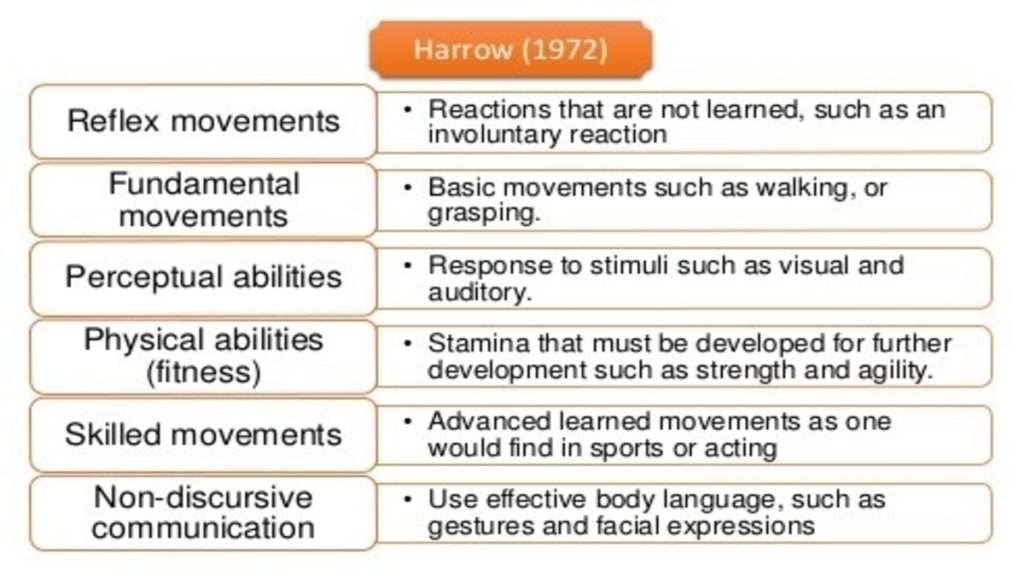Anita Harrow’s taxonomy (1972) of psychomotor domain focuses on the development of physical fitness, dexterity, agility, and body control to achieve a high level of expertise. Harrow’s taxonomy is organized according to the degree of coordination including involuntary responses and learned capabilities. It starts with the simple reflexes and goes to complex highly expressive movements requiring coordination and precision.
Harrow (1972) does not describe her model in relation to a general, unique criterion, but simply looks for a critical order. Mastery at an inferior level is absolutely necessary to achieve the immediately higher in the hierarchy of movements. Harrow’s taxonomy seems to be of direct use to teachers in physical education. Level 3 of Harrow’s taxonomy is especially interesting for preschool and for elementary school teachers. It contains a good example of a battery for testing the perceptive abilities of pupils, diagnosing difficulties, and proposing appropriate remedial exercises.
Levels of Psychomotor Domain of Learning
Anita Harrow’s taxonomy (1972) for the psychomotor domain is organized according to the degree of coordination including involuntary responses as well as learned capabilities. Simple reflexes begin at the lowest level of Harrow’s taxonomy, while complex neuromuscular coordination make up the highest levels (Seels & Glasgow, 1990).
1. Reflex Movements
Reflex (Involuntary) movements are automatic reactions elicited without learning in response to some stimuli. These are the reactions that are not learned, such as a involuntary reactions, segmental, intersegmental, and suprasegmental reflexes.
Key Words (Verbs) — To flex, to stretch, to straighten, to extend, to inhibit, to lengthen, to shorten, to tense, to stiffen, to relax.
Examples (Observable Behavior) — The learner; Responds physically instinctively.
2. Fundamental Movements
Basic fundamental movements are inherent movement patterns which are formed by combining of reflex movements and are the basis for complex skilled movements. Basic movements can build more complex set of movements.
Key Words (Verbs) — To crawl, to creep, to slide, to walk, to jump, to run, to grasp, to reach, to tighten, to support, to handle.
Examples (Observable Behavior) — The learner; Changes location. Moves in space while remaining in one place. Moves extremities in coordinated fashion.
3. Perceptual Abilities
Perceptual abilities refers to interpretation of various stimuli that enable one to make adjustments to the environment through visual, auditory, kinesthetic, or tactile discrimination. This entails cognitive as well as psychomotor behavior. It may include coordinated movements to respond to stimulus.
Key Words (Verbs) — To catch, to bounce, to eat, to write, to balance, to bend, to draw from memory, to distinguish by touching, to explore
Examples (Observable Behavior) — The learner; Discriminates visually e.g. Classify objects by colors. Discriminates auditory e.g. Differentiate sounds, track noises. Discriminates kinesthetically. Discriminates tactually. Coordinates two or more perceptual abilities e.g. Walk on rope without falling.
4. Physical Abilities
Physical abilities require endurance, strength, vigor, and agility which produces a sound, efficiently functioning body. This may include activities of strenuous effort for long period of time that results in muscular/cardiovascular endurance.
Key Words (Verbs) — To endure, to improve, to increase, to stop, to start, to move precisely, to touch, to bend.
Examples (Observable Behavior) — The learner; Exerts tension. Moves quickly. Stops immediately. Endures fatigue. e.g. Performs sit-ups, Wrestles in the ring, Bends a rod.
5. Skilled Movements
Skilled movements are the result of the acquisition of a degree of efficiency when performing a complex task. A high level of efficiency is achieved to perform a complex task.
Key Words (Verbs) — To waltz, to type, to play the piano, to plane, to file, to skate, to juggle, to paint, to dive, to fence, to golf, to change.
Examples (Observable Behavior) — The learner; Changes or modifies basic body movement patterns. Uses a tool or implement in adaptive or skilled manner. e.g. Improves catching and batting skills, Performs a hurdle run, Types words on computer.
6. Non-discursive Communication
Non-discursive communication is communication through bodily movements ranging from posture to gestures, creative movements, facial expressions, act a part in a play through sophisticated choreographics. Body postures, gestures, and facial expressions efficiently executed in skilled dance movement and choreographics.
Key Words (Verbs) — To gesture, to stand, to sit, to express facially, to dance skillfully, to perform skillfully, to paint skillfully, to play skillfully.
Examples (Observable Behavior) — The learner; Moves expressively. Moves interpretatively. Communicates emotions. Communicates esthetically. Expresses joy. e.g. Approves using a facial expression, gestures, posture. Performs a dance, drama, play, circus.
References
Harrow, Anita J. (1972). A Taxonomy of the Psychomotor Domain: A Guide for Developing Behavioral Objectives. New York: David McKay Co.
Seels and Glasgow (1990). Exercises in instructional design. Columbus OH: Merrill Publishing Company.
OTHER RELATED POSTS
Bloom’s Taxonomy of Educational Objectives
